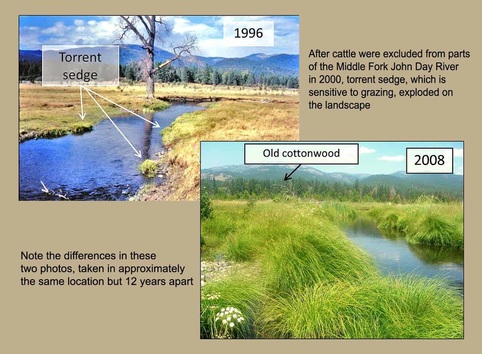|
By Emily Davis  What do you think of when you hear the word ‘engineer’? For many, the term conjures an image of activity, of working hard to build or change something. An ecosystem engineer is a living thing that dramatically changes its surrounding environment, influencing habitat for many other critters along the way. Beavers are a classic example of an ecosystem engineer. Their dam-building floods valleys, transforming running streams into deep, still ponds and wetlands, often creating lush oases in the middle of otherwise arid lands. River restoration practitioners applaud beavers because they save us a lot of work. But what if a plant—a sedentary being— could be an engineer? The humble torrent sedge (Carex nudata), a water-loving plant native to many rivers in Oregon and California, may be just such an unsung hero. In the Middle Fork John Day River, the torrent sedge has been quietly changing its landscape just as much as any busy beaver, but without all the hustle and bustle and fanfare. Since the 1990s, the Middle Fork has been the focus of enormous and complex restoration efforts to repair the damage done by previous logging, gold dredging, and cattle grazing. In 2001, the Confederated Tribes of Warm Springs acquired the Forrest and Oxbow Conservation Areas on the Middle Fork, and promptly built fences to exclude cows from the river. Simply as a result of removing cattle grazing from the riverbanks, torrent sedge exploded across the landscape. And when that happened, it didn’t escape the notice of Dr. Patricia McDowell, from the University of Oregon’s Department of Geography. McDowell, a geomorphologist, had been working on the Middle Fork for awhile, and had her eye on torrent sedge the whole time. For years, she wondered about its potential role in restoration. When PhD student Matthew Goslin expressed an interest in torrent sedge, a long-awaited research project was finally able to begin. “The first time I saw torrent sedge in the Middle Fork, I just thought it was an incredibly beautiful plant, and I wanted to learn more about it,” says Goslin. “Lots of researchers focus on problems, on negative issues or what’s going wrong. I was really drawn to the idea of learning about this plant that seemed to be doing positive things [in the river].” Until recently, fluvial geomorphology—the study of rivers, their shape and how they change—focused on physical processes like the movement of water and sediment. Plants were more or less ignored as agents of change. But that line of thinking is beginning to change. These days, researchers acknowledge plants as playing a role in changing river shapes, flow, erosion and sedimentation in complex ways. Goslin’s research aims to advance this idea that the plant-river relationship is reciprocal: that plants can alter the shape of the river just as the shape of the river can influence plant communities. When it comes to standing up to the power of the river, torrent sedge is tough. The plants build small, impenetrable fortresses, called ‘tussocks,’ with their dense root systems. These root balls are so tenacious that McDowell and Goslin began imagining them as ‘organic boulders.’ These ‘organic boulders’ are immobile objects in the river that can withstand fast currents and redirect flows; but that also grow and reproduce, building islands as they do so. As a result, torrent sedge appears to be changing the shape of the river from a simple, single-thread channel to a complex multi-threaded channel, creating a rich diversity of habitat for fish and other creatures. River restoration practitioners, like those working on the Oxbow Conservation Area, increasingly think of the unassuming torrent sedge as a positive contributor to the river landscape. Torrent sedge is now being transplanted into restoration projects, but with only a vague understanding of its potential function. Understanding how exactly it may change the river is essential for using it effectively in restoration work. To do the very same channel-shaping work as this modest plant, human engineers require heavy machinery like excavators, hundreds of thousands of dollars, dozens of meetings, and detailed blueprints of how to reconfigure the river. But all the torrent sedge needs is time. And, bonus feature: It does its work for free.
0 Comments
|
IMW News Updates
Archives
September 2022
Categories |
 RSS Feed
RSS Feed
